You'll find Amish butter churning stands apart through its blend of time-honored tradition and exceptional quality. At 84-85% butterfat content, it surpasses both American and European standards, creating an ultra-creamy texture and distinctive tangy flavor. The process often involves families working together using both traditional wooden churns and modern equipment, passing techniques down through generations. Fresh cream from grass-fed cows and strict quality controls guarantee premium results, while sustainable practices maintain environmental integrity. From local farmer's markets to national distribution, this artisanal approach to buttermaking reveals why consumers willingly pay more for this cherished dairy tradition.
The Heritage of Amish Butter
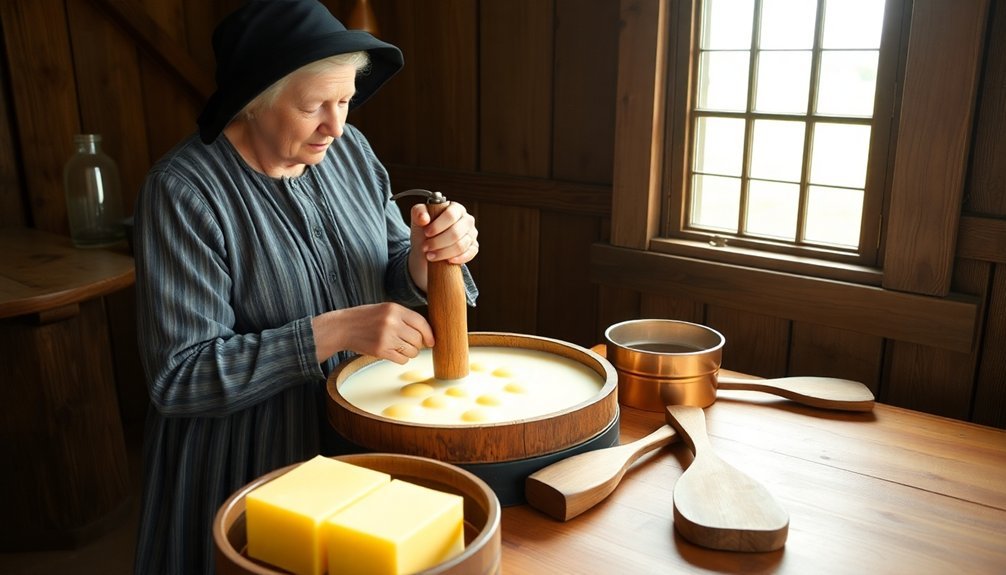
What's particularly remarkable is how butter production strengthens Amish community bonds.
You'll often see families working together in the churning process, passing down time-honored techniques through generations. This collaborative effort doesn't just preserve their cultural heritage – it also provides essential income for Amish families while supporting local economies and sustainable farming practices. Modern facilities can produce up to 20,000 pounds daily while still maintaining traditional quality standards.
Traditional Churning Equipment
The tools of Amish butter making blend both tradition and innovation. From historic wooden churns to modern stainless steel machines, you'll find a fascinating mix of equipment in Amish communities.
Modern commercial churns, like those made by Sunrise Metal in Topeka, Indiana, feature food-grade stainless steel construction and powerful 1 HP motors that can complete a batch in 20-30 minutes. These industrial units typically require a 4-6 week processing time for custom orders.
The shift from manual to powered churning hasn't eliminated traditional methods. You can still spot classic wooden churns and mason jar varieties that connect today's butter makers with their heritage.
The horizontal tub design, common in both old and new models, provides easy access and efficient processing.
- Commercial churns feature removable paddles and sanitary tri-clamp connectors for thorough cleaning
- Modern units include food-grade stainless steel construction with butterfly valves for drainage
- Home-use options include drill-powered churns with 4-gallon capacity
- Historical churns ranged from simple mason jars to wagon-motion churns used during frontier travel
- Traditional wooden churns and butter paddles remain popular for small-scale production
The evolution of churning equipment shows how Amish communities maintain their heritage while embracing practical innovations that improve efficiency and food safety.
From Cream to Gold
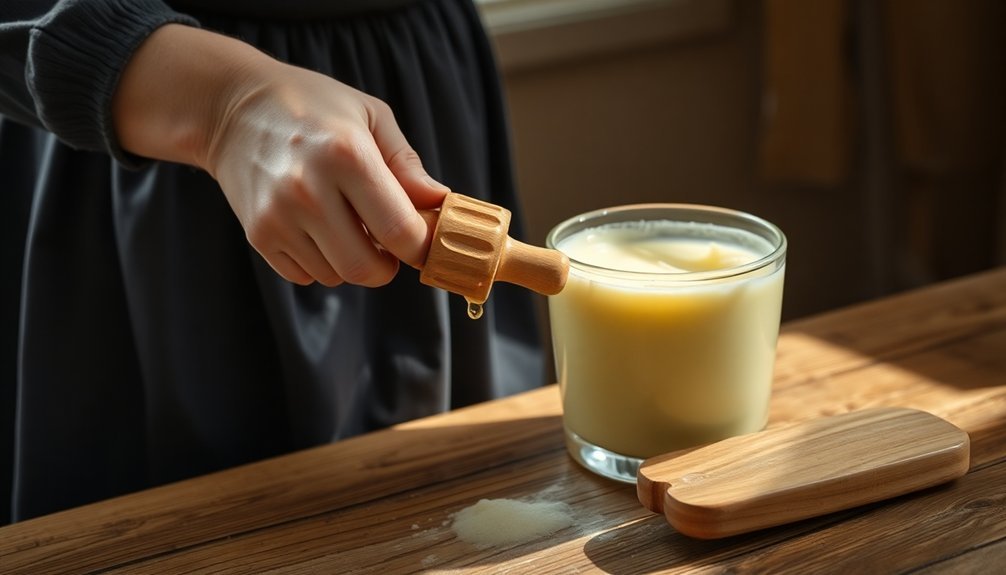
What you're creating is a butter with an impressive 84-85% butterfat content, surpassing both American and European styles.
You'll recognize authentic Amish butter by its ultra-creamy texture and distinctive tangy, milky flavor. The color can vary from pale to deep yellow, depending on the cows' diet.
The final product is traditionally shaped into rolled logs and wrapped in parchment paper, ready for storage or immediate use in your favorite recipes. Modern producers like Minerva Dairy maintain these quality standards while producing thousands of pounds daily.
Community Spirit in Production
Making Amish butter embodies a deeply collaborative spirit, where entire communities come together to transform cream into their prized dairy product.
You'll find families working side by side, sharing equipment and expertise while strengthening their cultural bonds through this time-honored tradition. The process isn't just about creating butter; it's about preserving heritage and fostering economic stability within the community.
While traditional methods remain at the heart of Amish butter production, you'll notice they've adapted to modern needs without compromising their values.
They've incorporated efficient equipment like electric churns and improved storage methods to meet market demands while maintaining their commitment to quality and authenticity.
- Neighbors often share the workload during peak production times, making the process more efficient and enjoyable
- Community members collaborate on packaging and distribution, ensuring fresh butter reaches local markets
- Multi-generational knowledge transfer occurs naturally as experienced butter makers work alongside younger members
- Shared equipment and resources help reduce individual family costs while maximizing production
- Collective marketing efforts through local partnerships strengthen the community's economic foundation
Quality Control Standards
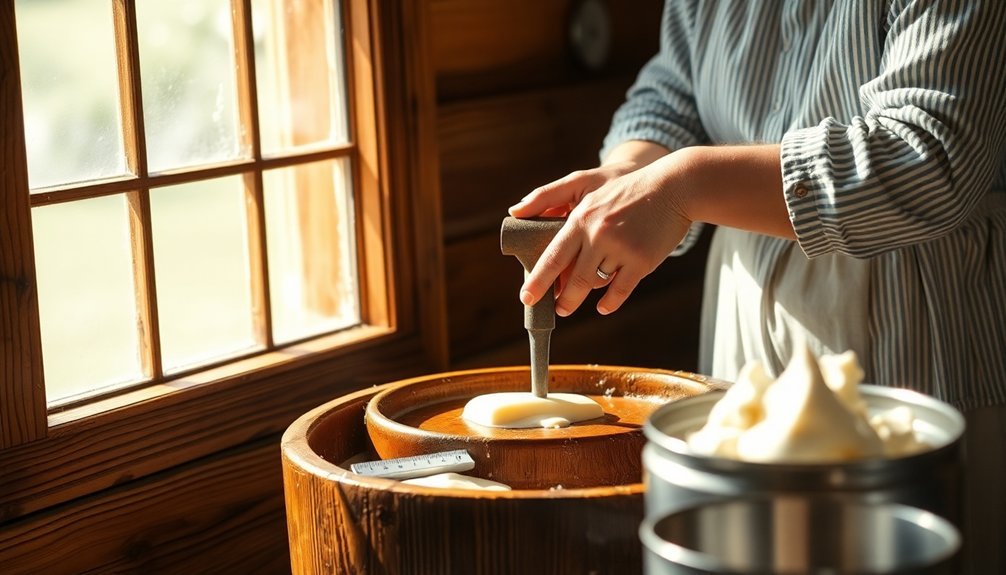
Maintaining rigorous quality control standards sets Amish butter apart in today's dairy market. You'll find that every aspect of production must meet strict requirements, from butterfat content to equipment specifications.
The hallmark of Amish butter is its impressive 84-85% butterfat content, surpassing both American and European standards, which creates that distinctively rich, creamy texture you've come to expect.
The slow-churning process you'll see in Amish butter production isn't just for show – it's carefully controlled to minimize air incorporation and preserve butterfat integrity.
Even large-scale producers like Minerva Dairy maintain these exacting standards while churning 20,000 pounds daily. You'll notice the difference in the final product, which comes in distinctive one- or two-pound rolled logs wrapped in parchment paper.
Behind the scenes, you'll find strict adherence to USDA guidelines and 3-A Sanitary Standards.
The equipment must be made from specific materials, like 304 #4 brushed food-grade stainless steel, ensuring both safety and cleanliness. Regular inspections and standardized sanitization procedures guarantee that every batch meets the highest quality benchmarks.
Grass-Fed Dairy Practices
The quality of Amish butter begins long before the churning process, starting with the cows' carefully managed grass-fed diet.
You'll find Amish farmers prioritizing a natural, grain-free approach where their cows graze on diverse pastures filled with grasses, legumes, and forbs. They're committed to maintaining strict grazing practices that keep their cows on pasture throughout the growing season, far exceeding the minimum 120-day requirement set by USDA Organic standards.
What makes this approach special is the dedication to both animal welfare and environmental sustainability.
You'll notice that Amish farmers rotate their pastures carefully to prevent overgrazing and maintain soil health. They don't use synthetic hormones, antibiotics, or genetically engineered feeds, which results in healthier cows producing higher quality milk for butter production.
- Cows graze on diverse pastures containing multiple species of grasses and legumes
- Pasture rotation practices maintain ideal soil health and grass quality
- No grain supplements – just pure, natural forage-based nutrition
- Cows spend their days outdoors during the entire growing season
- Enhanced milk quality through natural, hormone-free farming methods
These grass-fed practices directly influence the butter's flavor, texture, and nutritional profile, making Amish butter distinctly different from conventional alternatives.
Modern Day Adaptations
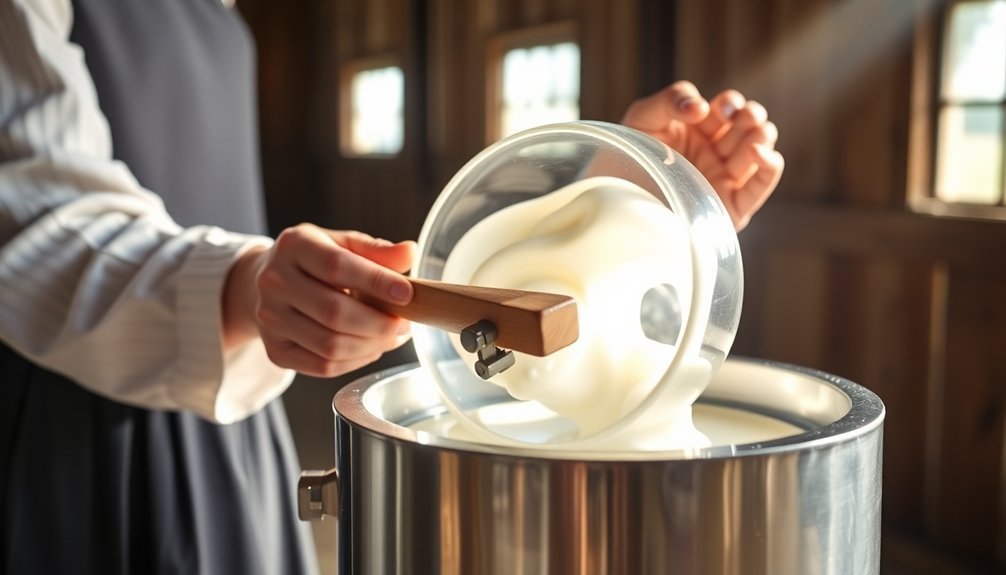
While Amish butter-making traditions remain deeply rooted in cultural heritage, modern producers have embraced strategic technological adaptations to meet growing market demands. You'll find large-scale operations using electric churners that can produce up to 20,000 pounds of butter daily while maintaining the slow-churning process essential for preserving butterfat integrity.
| Modern Adaptation | Traditional Benefit |
|---|---|
| Electric Churners | Preserves slow-churning technique |
| Temperature Control | Maintains consistent quality |
| Mechanized Equipment | Reduces air content for better texture |
Today's Amish butter producers, like Minerva Dairy, have successfully scaled their operations to produce millions of pounds annually without compromising quality. You'll notice they've implemented temperature-controlled storage and transportation systems to guarantee freshness and maintain the butter's rich, creamy texture. These adaptations allow producers to compete effectively in specialty markets while preserving their cultural significance. Through online sales and partnerships with grocery chains, you can now find authentic Amish butter in stores nationwide, making this artisanal product more accessible than ever. The integration of modern equipment has streamlined production while staying true to the core principles of traditional Amish butter-making.
Butter Storage Methods
Proper storage techniques play an essential role in preserving Amish butter's distinctive flavor and texture. You'll find several reliable methods to store your Amish butter, depending on your needs and timeline.
For short-term storage, you can keep a week's worth of butter in a covered dish on your counter, ensuring it's away from direct sunlight and heat sources.
If you're looking for longer preservation, refrigeration is your best option. Store the butter in a sealed container to maintain its quality and prevent it from absorbing other food odors.
For extended storage periods of up to two years, wrap the butter in its original packaging plus an extra layer of plastic before freezing it in an airtight container.
A butter bell or crock offers a specialized storage solution, keeping your butter at room temperature for up to 30 days while maintaining its spreadability. Remember to change the water regularly and store it in a cool spot.
- Keep refrigerated butter in a sealed container
- Use a butter bell for room temperature storage
- Wrap thoroughly before freezing
- Store away from strong-smelling foods
- Check regularly for signs of spoilage
Culinary Applications

Rich, creamy Amish butter serves as a culinary powerhouse in numerous recipes, transforming ordinary dishes into extraordinary culinary experiences.
You'll find its higher butterfat content (at least 84%) especially beneficial in baking, where it enhances the flavor and texture of pie crusts, Swedish butter cookies, and various pastries.
When you're cooking savory dishes, you can rely on Amish butter's distinctive tanginess and ultra-creamy texture to elevate your sauces and sautéed items.
It's particularly effective in creating luxurious cheese sauces and herb butters, where its natural flavors shine through thanks to minimal processing.
You'll notice its exceptional performance in breakfast classics too, adding a rich, milky quality to pancakes and waffles.
For special dishes, try incorporating Amish butter into traditional recipes where butter plays a starring role.
You can easily substitute it in any recipe calling for regular butter, from Kodiak Cake Cookies to blueberry muffins.
The butter's natural color variations, ranging from pale to deeper yellow, will add visual appeal to your finished dishes, while its hand-rolled texture guarantees ideal flavor distribution in everything you prepare.
Sustainable Production Techniques
You'll find Amish butter producers maintaining sustainable practices through their adherence to traditional hand-churning methods, which minimize energy consumption and preserve time-honored techniques.
Their low-impact dairy operations rely on pasture-raised cows and local sourcing, reducing transportation emissions and supporting regional farming communities.
The waste-free production cycle guarantees every component of the process serves a purpose, from using excess buttermilk in baking to composting organic materials for fertilizer.
Traditional Hand-Churning Methods
The gentle rhythm of wooden churns echoes through Amish communities as families transform premium cream into golden butter using time-honored techniques.
You'll find this traditional process begins with selecting premium milk from pasture-raised cows, free from artificial hormones and antibiotics. The churning itself is a methodical process, taking about 10 minutes as the cream is agitated until the butterfat separates from the buttermilk.
What makes Amish butter truly special is its communal nature and superior quality. You'll often see families and community members working together, preserving these time-tested methods while creating butter with at least 84% butterfat content.
This higher fat content results in an ultra-creamy texture and distinctive tangy flavor that you won't find in commercial alternatives.
Here's what makes Amish butter churning distinct:
- Uses premium milk from local, family-owned farms
- Involves traditional wooden churns or adapted mechanized equipment
- Creates natural separation of butterfat from buttermilk
- Maintains higher butterfat content (84%+)
- Results in unique presentation as logs or rolls wrapped in parchment
Low-Impact Dairy Operations
Modern Amish dairy operations seamlessly blend traditional values with sustainable practices, creating a model of environmental stewardship.
You'll find their farms implementing rotational grazing techniques that maximize pasture usage while improving soil health naturally. Their commitment to low-impact methods, particularly in mountain pastures with naturally-fed dairy cows, greatly reduces carbon footprints.
While many Amish communities maintain traditional methods, they've adopted select sustainable technologies that align with their values.
You'll notice their efficient water recycling systems and precision feeding approaches that reduce waste while ensuring ideal nutrition for each cow. They're particularly adept at manure management, using it as natural fertilizer for their fields and pastures.
Their dairy operations often incorporate cover crops in feed production, which enhances soil health and prevents erosion.
You'll see careful attention paid to pasture management through strategic rotation and natural fertilization methods, boosting milk production sustainability.
Waste-Free Production Cycle
Within Amish butter-making operations, sustainable practices create a remarkably efficient waste-free cycle that maximizes every component of dairy production. You'll find that byproducts like buttermilk don't go to waste but instead become valuable ingredients for baking and cooking. The high butterfat content guarantees minimal cream waste, while cream that doesn't meet butter standards gets redirected into cheese or yogurt production.
The process maintains efficiency through minimal processing steps. You won't see unnecessary homogenization, and while some operations use electric churners, they're careful to preserve traditional quality standards. The local, community-oriented approach means shorter supply chains and fresher products, with many farmers working within a close radius of the production facility.
Storage and packaging solutions reflect this waste-conscious approach. You'll appreciate the biodegradable parchment wrapping and efficient roll shapes that use less packaging material than conventional butter sticks.
- Buttermilk becomes a versatile ingredient for other products
- Non-GMO veggie rennet offers a sustainable alternative to animal-derived options
- Local sourcing reduces transportation waste and supports community farmers
- Simple processing methods preserve nutrient quality
- Biodegradable packaging minimizes environmental impact while maintaining freshness
Market Impact and Distribution
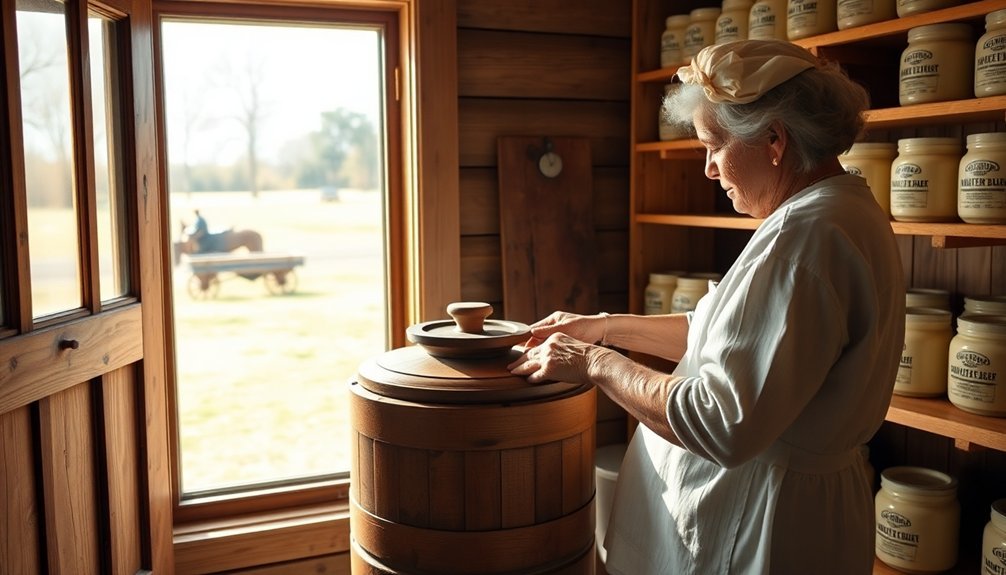
You'll find Amish butter readily available through local distribution networks, including specialty markets, farmer's markets, and even major grocery chains like Publix.
The traditional packaging in parchment-wrapped logs and sticks allows producers to maintain authenticity while meeting modern retail standards.
As an artisanal product with higher butterfat content and traditional production methods, Amish butter commands premium prices, supporting the economic sustainability of Amish communities.
Local Distribution Networks Today
The distribution of Amish butter has branched out far beyond traditional local markets, reaching consumers through diverse channels that include specialty stores, farmers' markets, and major grocery chains.
You'll find Amish butter products in upscale restaurants and cooperative arrangements, while online platforms have expanded their reach to national and international customers.
Today's local distribution networks blend traditional direct sales with modern marketing approaches. You can purchase authentic Amish butter through multiple channels that maintain the product's integrity while meeting contemporary consumer demands.
Intermediary companies often bridge the gap between Amish producers and larger retail operations, helping traditional dairy farms adapt to increasing market pressures.
- Find authentic Amish butter at local farmers' markets where producers sell directly to customers
- Purchase through specialty food stores that maintain relationships with Amish communities
- Order online from verified Amish dairy cooperatives that ship nationwide
- Buy from major grocery chains that partner with established Amish dairy operations
- Visit tourist-oriented shops in Amish regions that offer fresh, locally produced butter
Artisanal Pricing Strategy
Premium pricing stands out as a hallmark of authentic Amish butter, with prices ranging from $5.49 to $28 per roll across various retailers. You'll find this artisanal product commanding higher prices due to its superior 84-85% butterfat content and traditional slow-churning process. These premium prices help support local farming economies while reflecting the product's exceptional quality and unique production methods.
You can purchase Amish butter through various channels, from specialty markets to national chains like Publix and Albertsons. E-commerce platforms have expanded accessibility, though shipping costs may increase the final price.
| Retail Channel | Typical Price Range | Availability |
|---|---|---|
| Specialty Markets | $8-15/lb | Limited |
| National Chains | $5.49-12/lb | Widespread |
| Online Platforms | $15-28/lb | Global |
The pricing strategy capitalizes on consumers' willingness to pay more for artisanal products, particularly those seeking hormone-free, preservative-free options. Bulk purchasing can offset costs, though prices vary by brand and retailer. Companies like Minerva Dairy and Amish Country Roll Butter offer different sizes and flavors, contributing to price variations while maintaining the product's artisanal appeal.
Frequently Asked Questions
How Does Amish Butter Taste Different From Regular European Cultured Butter?
You'll taste a richer, creamier flavor in Amish butter with its higher butterfat content (84-85%), while lacking the tangy, sour notes found in European cultured butter due to its fermentation process.
Can Amish Butter Be Consumed by People With Lactose Intolerance?
You can likely enjoy Amish butter if you're lactose intolerant since it contains minimal lactose after churning. Like other butters, it's mostly butterfat, but your individual tolerance levels may still vary.
Why Does Amish Butter Sometimes Have a Marbled Appearance?
You'll notice marbling in Amish butter due to its high butterfat content and slow-churning process. The uneven distribution of fat globules and occasional buttermilk pockets create this unique, marbled appearance during production.
How Many Hours of Churning Are Required for One Batch?
You'll typically spend between 30 minutes to an hour churning one batch of butter by hand. If you're using modern electric equipment, you can complete the process in about 45 minutes.
Does Consuming Amish Butter Affect Cholesterol Levels Differently Than Regular Butter?
No, your cholesterol levels won't be affected differently by Amish butter compared to regular butter. They have similar fat compositions and saturated fat content, which both can raise LDL cholesterol when consumed excessively.
In Summary
You'll find that Amish butter churning represents more than just dairy production – it's a tribute to time-honored traditions, sustainable practices, and community values. Whether you're spreading it on fresh bread or using it in your baking, you're tasting generations of craftsmanship. By supporting Amish butter makers, you're helping preserve these authentic methods while enjoying one of the finest dairy products available.

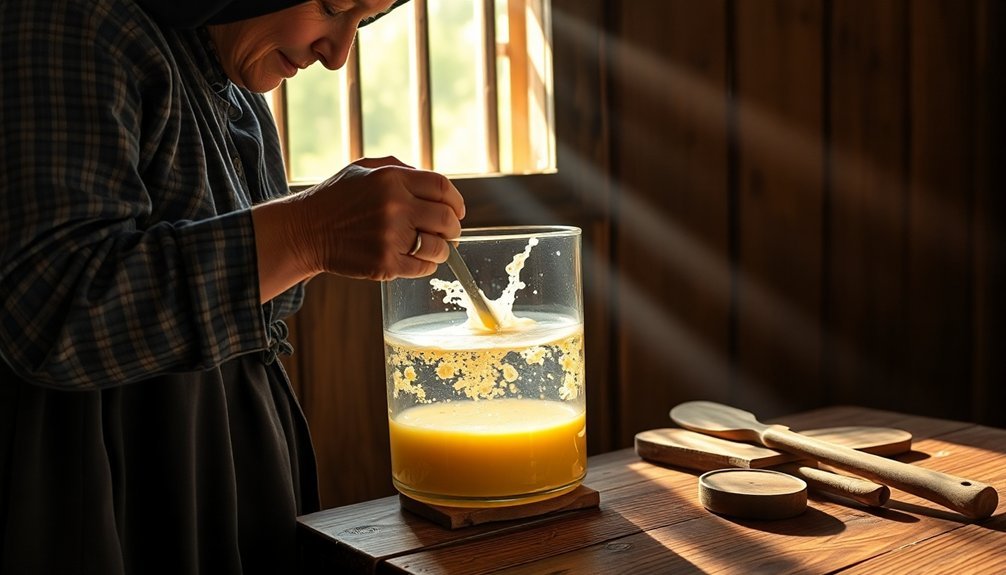



Leave a Reply